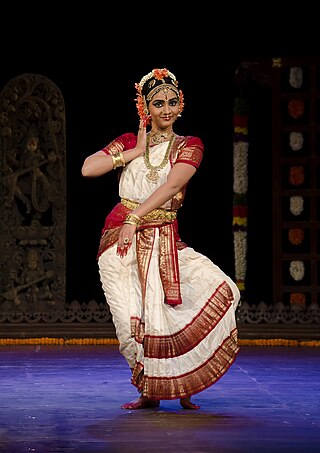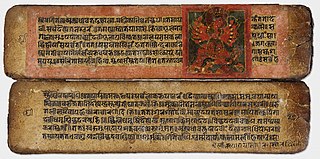
Kālidāsa was a Classical Sanskrit author who is often considered ancient India's greatest poet and playwright. His plays and poetry are primarily based on Hindu Puranas and philosophy. His surviving works consist of three plays, two epic poems and two shorter poems.
Bharata was a muni (sage) of ancient India. He is traditionally attributed authorship of the influential performing arts treatise Natya Shastra, which covers ancient Indian dance, dramaturgy, poetics, and music.

Kuchipudi is one of the eight major Indian classical dances. It originates from a village named Kuchipudi in the Indian state of Andhra Pradesh. Kuchipudi is a dance-drama performance, with its roots in the ancient Hindu Sanskrit text of Natya Shastra. It developed as a religious art linked to traveling bards, temples and spiritual beliefs, like all major classical dances of India.
Indian literature refers to the literature produced on the Indian subcontinent until 1947 and in the Republic of India thereafter. The Eighth Schedule to the Constitution of India has 22 officially recognised languages. Sahitya Akademi, India's highest literary body, also has 24 recognised literary languages.

Sanskrit literature broadly comprises all literature in the Sanskrit language. This includes texts composed in the earliest attested descendant of the Proto-Indo-Aryan language known as Vedic Sanskrit, texts in Classical Sanskrit as well as some mixed and non-standard forms of Sanskrit. Literature in the older language begins with the composition of the Ṛg·veda between about 1500 and 1000 BCE, followed by other Vedic works right up to the time of the grammarian Pāṇini around 6th or 4th century BCE.
Hindu texts or Hindu scriptures are manuscripts and voluminous historical literature which are related to any of the diverse traditions within Hinduism. Some of the major Hindu texts include the Vedas, the Upanishads, and the Itihasa. Scholars hesitate in defining the term "Hindu scriptures" given the diverse nature of Hinduism, but many list the Agamas as Hindu scriptures, and Dominic Goodall includes Bhagavata Purana and Yajnavalkya Smriti in the list of Hindu scriptures as well.

The Nāṭya Shāstra is a Sanskrit treatise on the performing arts. The text is attributed to sage Bharata, and its first complete compilation is dated to between 200 BCE and 200 CE, but estimates vary between 500 BCE and 500 CE.

Indian classical dance, or Shastriya Nritya, is an umbrella term for different regionally-specific Indian classical dance traditions, rooted in predominantly Hindu musical theatre performance, the theory and practice of which can be traced to the Sanskrit text Natya Shastra. The number of Indian classical dance styles ranges from six to eight to twelve, or more, depending on the source and scholar; the main organisation for Indian arts preservation, the Sangeet Natak Academy recognizes eight: Bharatanatyam, Kathak, Kuchipudi, Odissi, Kathakali, Sattriya, Manipuri and Mohiniyattam. Additionally, the Indian Ministry of Culture includes Chhau in its list, recognising nine total styles. Scholars such as Drid Williams add Chhau, Yakshagana and Bhagavata Mela to the list. Each dance tradition originates and comes from a different state and/or region of India; for example, Bharatanatyam is from Tamil Nadu in the south of India, Odissi is from the east coast state of Odisha, and Manipuri is from the northeastern state of Manipur. The music associated with these different dance performances consists many compositions in Hindi, Malayalam, Meitei (Manipuri), Sanskrit, Tamil, Odia, Telugu, and many other Indian-Subcontinent languages; they represent a unity of core ideas and a diversity of styles, costumes, and expression.

Dance in India comprises numerous styles of dances, generally classified as classical or folk. As with other aspects of Indian culture, different forms of dances originated in different parts of India, developed according to the local traditions and also imbibed elements from other parts of the country.
In Indian aesthetics, a rasa literally means "juice, essence or taste". It is a concept in Indian arts denoting the aesthetic flavour of any visual, literary or musical work that evokes an emotion or feeling in the reader or audience, but cannot be described. It refers to the emotional flavors/essence crafted into the work by the writer or a performer and relished by a 'sensitive spectator' or sahṛidaya, literally one who "has heart", and can connect to the work with emotion, without dryness.
Bhāsa is one of the earliest Indian playwrights in Sanskrit, predating Kālidasa. Estimates of his floruit range from the 4th century BCE to the 4th century CE; the thirteen plays attributed to him are commonly dated closer to the first or second century CE.

Theatre of India is one of the most ancient forms of theatre and it features a detailed textual, sculptural, and dramatic effects which emerged in mid first millennium BC. Like in the areas of music and dance, the Indian theatre is also defined by the dramatic performance based on the concept of Nritya, which is a Sanskrit word for drama but encompasses dramatic narrative, virtuosic dance, and music. Historically, Indian theatre has exerted influence beyond its borders, reaching ancient China and other countries in the Far East.
Shudraka was an Indian playwright, to whom three Sanskrit plays are attributed: Mrichchhakatika, Vinavasavadatta, and a bhana, Padmaprabhritaka. According to the prologue of Mrichchhakatika, he was a king; according to one theory, he may have been a third century Abhira king. According to another theory, Shudraka is a mythical figure, and the authorship of plays attributed to him is uncertain. Col. Wilfred has identified him with Simuka, the founder of Satavahana dynasty and placed him in 200 B.C.
Vishakhadatta was an Indian Sanskrit poet and playwright. Although Vishakhadatta furnishes the names of his father and grandfather as Maharaja Bhaskaradatta and Maharaja Vateshvaradatta in his political drama Mudrārākṣasa, we know little else about him. Only two of his plays, the Mudrārākṣasa and the Devichandraguptam are known to us. His period is not certain but he probably flourished in or after the 6th century CE. Some scholars such as A. S. Altekar, K. P. Jayaswal and Sten Konow theorized that Vishakhadatta was a contemporary of Chandragupta II, and lived in late 4th century to early 5th century. But this view has been challenged by other scholars, including Moriz Winternitz and R. C. Majumdar.

Drama is the specific mode of fiction represented in performance: a play, opera, mime, ballet, etc., performed in a theatre, or on radio or television. Considered as a genre of poetry in general, the dramatic mode has been contrasted with the epic and the lyrical modes ever since Aristotle's Poetics —the earliest work of dramatic theory.
Shanta Kalidas Gandhi was an Indian theatre director, dancer and playwright who was closely associated with IPTA, the cultural wing of the Communist Party of India. She studied with Indira Gandhi at a residential school in the early 1930s, and remained close to the prime minister in later life. She received many government awards and sinecures under the Indira Gandhi administration, including the Padma Shri (1984) and being made chairperson of the National School of Drama (1982–84).

Nritya, also referred to as nritta, natana or natya, is "dance, act on the stage, act, gesticulate, play" in the Indian traditions. It is sometimes subdivided into two forms: nritta or pure dance, where the expressionless movements of a dancer play out the rhythms and phrases of the music; and nritya or expressive dance, where the dancer includes facial expression and body language to portray mood and ideas with the rhythmic movements.
Pratijnayaugandharayana is a Sanskrit play in four acts written by the ancient Indian poet Bhāsa. It is the oldest extant political play of India and the prequel to Bhāsa's Svapnavasavadattam. These plays were written by Bhāsa on the account of Udayana, king of Vatsa (Kaushambi).










